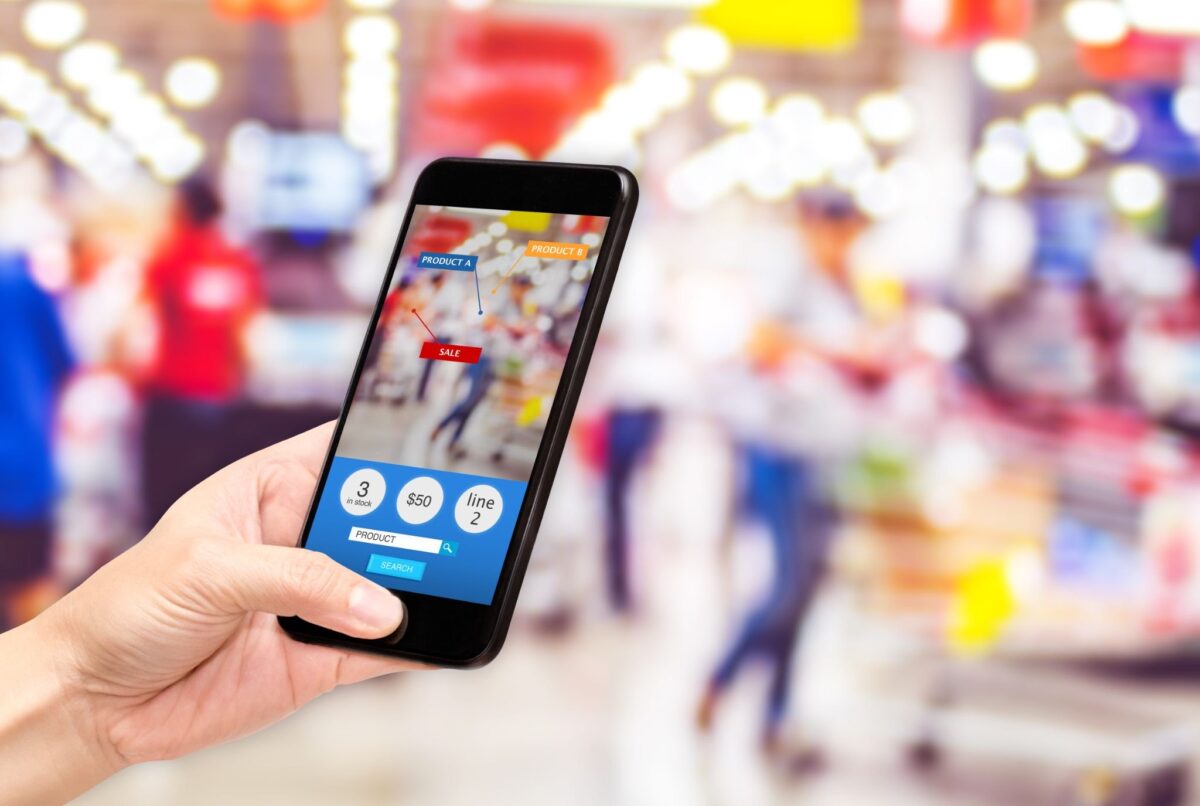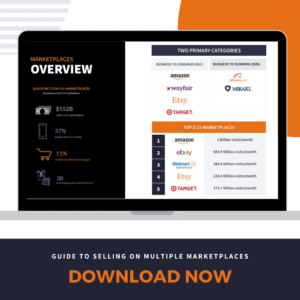Multichannel retail is the biggest opportunity for merchants of all sizes to expand their market share and drive exponential growth. This guide offers practical tips for expanding your business into new sales channels.
2021 Ultimate Multichannel Retailing Guide


With consumers conducting research and purchasing in more places now than ever, multichannel retail is the best way to attract new customers, drive repeat business, and expand market share.
Consider a clothier like Levi’s, which develops, produces, markets, and distributes denim wear and associated apparel. They sell their products online and offline across tens of thousands of company-owned stores, big box retailers, department stores, specialty stores, websites, and mobile apps.
As the National Retail Federation reports, the biggest takeaway from the past two years is the shift to eCommerce and enthusiasm with which consumers have embraced online shipping during the pandemic. As eMarketer predicts, multichannel sales will continue growing faster and comprise a larger share of the total eCommerce market.
Looking ahead then, it’s clear why sellers relying solely on one sales channel must make the leap into multi-channel retailing.
What do you mean by multichannel retailing?
Multichannel retailing comprises selling on multiple offline and online sales channels simultaneously to meet modern consumers’ expectations. Their final purchase will be made in one place, but numerous touchpoints facilitate the buying decision process along the way.
Business Insider recently reported that 82% of consumers have researched products online before making an in-store purchase. Also, 56% said they showed up in-store to check out products first and then purchased online later.
Accordingly, 87% want a consistent, personalized “start anywhere and finish anywhere” experience across all shopping channels. This includes a higher degree of transparency from retailers and synergy across devices.
For example, almost 6 out of 10 surveyed indicated that they’re more likely to frequent a shop which provides a shared cart across all digital channels. Additionally, almost 7 out of 10 stated they’d be more likely to purchase from stores offering inventory visibility across digital channels over stores that do not.
The Evolution of Multichannel Retail
With the rapid growth of ecommerce, multichannel retail has evolved exponentially in recent years. Big retailers like Walmart have expanded their online presence and in an effort to grow their ecommerce catalogue, are adding more and more third party sellers. In fact, Walmart Marketplace is adding an estimated 5,000 new third party sellers each month. This is a dramatic change in the ecommerce marketplace ecosystem, making Walmart Marketplace the second most important marketplace for merchants, second only to Amazon.
Not only have some of the major players become more aggressive in carving out their share of the market, more new and independent marketplaces have come on the scene, especially since the shift to a digital-first economy ushered in by 2020 shutdowns. The growing B2B marketplace sector is projected to reach $3.6 trillion in sales by 2024. However, brick and mortar retail is still an important component of a multichannel strategy. With buy online pickup in store (BOPIS) fulfillment options and in-store returns, a presence on the shelves of retail stores is a major leg-up for SMB’s.
What are the different modes of multichannel retailing?
While the internet changed the way we shop, multichannel retailing has been around for centuries. Sears got its start as a mail order business in the late 1800s before opening stores across the country.
Below are the 5 most common retail channels seen today:
- Brick-and-Mortar Store – Physical locations give sellers the ability to connect with customers face-to-face and historically were the primary distribution channel. Now, retail juggernauts like Walmart use their vast brick-and-mortar footprint as mini-fulfillment centers to get goods to consumers faster and cheaper.
- Consumer Direct E-Commerce – Direct-to-consumer (D2C) allows shops of all sizes to sell products straight to consumers without relying on wholesalers or third-party retailers. All that is required to start selling is a website or mobile app.
- Social Media – Social media has evolved from a product research and paid advertising platform to another sales channel. Buying from select brands on social media platforms, such as Instagram, Facebook, and Pinterest, without leaving the app has become commonplace.
- Online Marketplaces – Led by Amazon, ecommerce marketplaces like eBay, Etsy, Rakuten and Walmart Marketplace act as single, centralized buying centers mostly selling goods from third-party vendors. Like the convenience of traditional big box stores, online marketplaces offer wide selection and inexpensive shipping options. Consequently, the reach and scale of these e-commerce giants has forced shops to adapt and play by their rules.
- Catalogs – The Internet has made mail-order catalogs rarer, but direct mail is far from dead. Patagonia, Crate and Barrel, and Nordstrom are just a few of the retailers investing big in catalogs, according to Harvard Business Review. Also, pure-online retailers like Wayfair and Birchbox include catalogs in their strategy to take advantage of less competition for mailboxes than inboxes.
What is the difference between omnichannel and multichannel retailing?
Multichannel retailing is often used interchangeably with omnichannel retailing. While both rely on selling to consumers across various sales channels, there’s one key difference the two:
Product vs Customer Focus – Multichannel is the practice of selling several products across multiple sales channels, whereas omnichannel’s focus is on the customer across numerous channels.
In other words, in multichannel, retail product is the centerpiece, with each channel providing an independent, separate purchase opportunity. The user experience of these channels is not connected as it would be in an omnichannel scenario.
Multichannel sellers’ success hinges on measuring sales in each channel and evolving user experience and marketing to maximize conversions.
For instance, shoppers see a social media ad for a pair of boots. They scroll through the post’s comments to see what others are saying about the boots. Then, they click the ad to read the full product description and read reviews on the merchant’s website. Next, they search for the boots online to compare prices, shipping costs, and 3rd party reviews. During the following week, they’re served retargeting ads reminding them about the benefits and low price of the boots.
At all steps along this journey, customers can learn more about the product and purchase.
What are the advantages and disadvantages of multichannel retailing?
Four Advantages
- Low Entry Point – Businesses can get up and running, establishing new revenue streams across multiple digital channels without ever opening a physical store. Products can be exposed to thousands of first-time buyers in new online marketplaces or geographies cheaply.
- Bigger Audience – Giving customers more ways to buy means shops get in front of more customers more frequently. Multichannel retailing allows customers to buy based on their convenience and comfort. Further, customers can quickly scan online reviews and social media posts to learn about others’ purchase experience. As a result, social influence built on rave reviews and testimonials is a powerful way for shops to attract new customers.
- Control Destiny – Selling across multiple channels diversifies risk in the event of an account suspension, supply chain breakdown, or algorithm change at an online marketplace. With a multichannel strategy in place, sellers aren’t reliant on a single platform that could change their rules at any time and hurt sales. Plus, stores have more control over brand equity and promotional material like customized packaging.
- Customer Data – More channels mean more opportunities to gather information about customers to reduce cart abandonment rates and drive repeat business. Typically, online marketplaces and third-party retailers provide merchant partners with data and detailed reports about customer behavior. Collecting this data in an actionable way allows sellers to retarget individual customers more effectively and optimize user experience on each platform.
Four Disadvantages
- Lack of Control – The increased complexity of multichannel retailing means managing thousands of SKUs and datapoints, while guaranteeing fast delivery through the last mile to provide an optimal customer experience. Moreover, shops have less – or even no control – over their brand message in third-party channels.
- Limited Resources – Selling across multiple channels requires proper fulfillment infrastructure from inventory management through processing orders – and even reverse logistics. The National Retail Foundation reported that consumers returned an estimated $428 billion in merchandise to retailers last year, which was almost 11% of total U.S. retail sales in 2020. Many businesses lack the expertise and budgets required for an in-house fulfillment operation that guarantees nationwide, 1-2-day delivery.
- Coordinating Inventory – Managing inventory across many sales channels is difficult, especially for small-and-medium-sized businesses lacking the resources of larger eCommerce players. Since each channel is independent, changes in one channel are not reflected in the others without a manual update. This inefficiency leads to costly stockouts or keeping customers waiting for product they thought was available, hurting brand reputation and future business. Success will be short-lived if the fulfillment process can’t scale with exponential business growth.
- Higher Costs – Multichannel retailing increases revenue long-term but it’s also expensive. Selling additional products in new places means extra setup, customization, suppliers, warehouses, and fulfillment staff – along with higher shipping and advertising costs.
Top 3 Challenges in Modern Multichannel Retailing
Of course, adding additional sales channels will complicate internal operations. The exponential growth potential of adopting a multichannel retailing strategy can make.
- Marketing: Advertising costs are on the rise, especially on Amazon, as they attempt to grow their advertising business into a main revenue stream. Managing marketing dollars across multiple platforms and monitoring performance across all channels can be a challenge for most SMB’s. Many merchants choose to partner with an Amazon agency to optimize their keyword strategy to improve conversion rates as well as manage their multichannel marketing strategy with a trusted CRM.
- Inventory Management: Juggling inventory across multiple channels can be difficult, especially when assessing which channels are most profitable and drive the most brand equity. Partnering with a tech-enabled 3PL with a cloud-based inventory management enables you to manage inventory across all sales channels through a single dashboard and redirect inventory to more profitable channels if any channels are under-performing.
- Fulfillment: Fulfillment requirements across sales channels can be hard to maintain while continuing to build brand equity and maintaining customer relationships. Finding a fulfillment partner that can manage fulfillment across all sales channels, whether B2B, B2C, marketplace, or direct, can simplify fulfillment and allow for more visibility and control over your brand.
Looking for a multichannel fulfillment solution? Talk to one of our fulfillment experts
The Bottom Line
In today’s anything, anywhere selling environment successful sellers have no choice but to expand into multichannel retailing. Luckily, fourth-party logistics (4PLs) providers exist to help sellers expand into new channels cost effectively.
These outsourced order fulfilment partners provide two primary benefits:
- Negotiate the best rates and service level agreements (SLAs) across regional 3PLs to create a nationwide distributed warehouse network.
- Help merchants determine where to forward stock inventory to guarantee nationwide 1-2-day delivery affordably.
Ware2Go is a 4PL created by UPS specifically to provide this level of service and help sellers in all growth phases promise 1-2-day shipping.
To learn more about how Ware2Go can help you optimize fulfillment across multiple sales channels, please reach out to one of our fulfillment experts.


